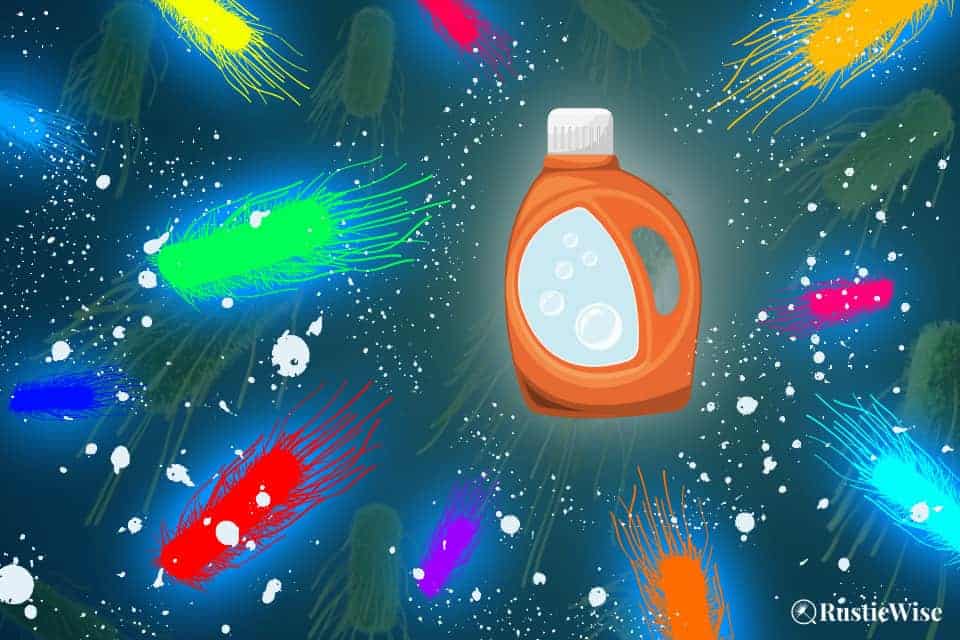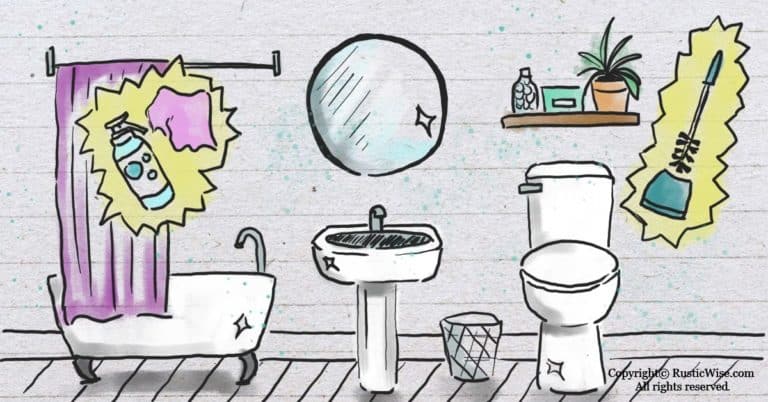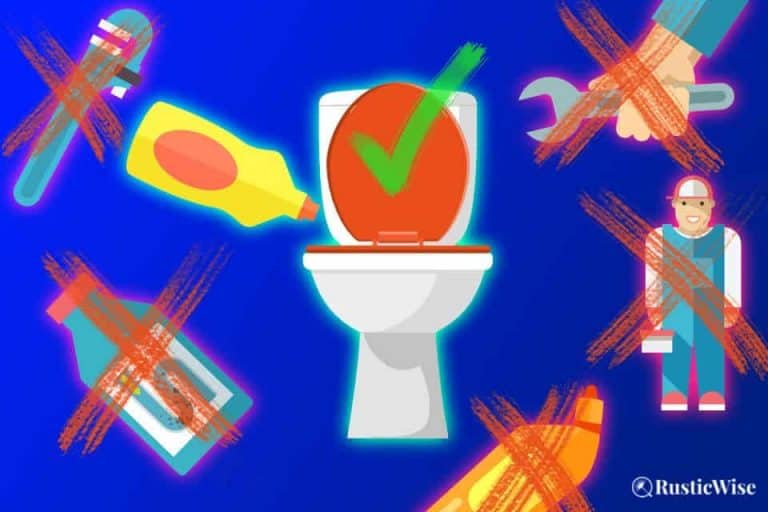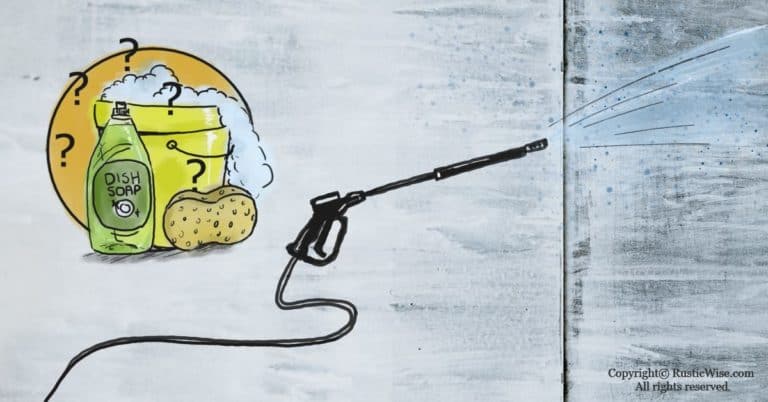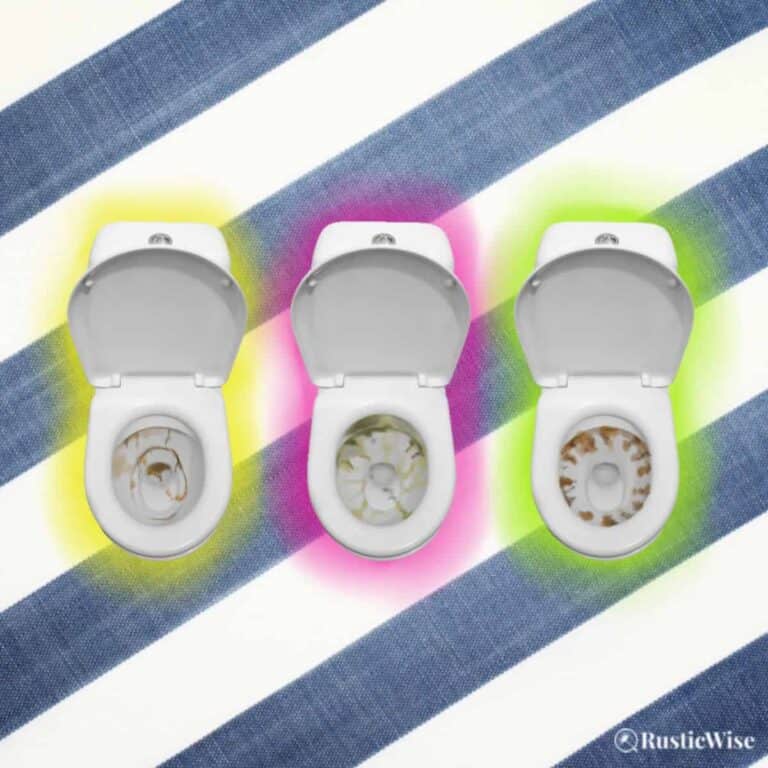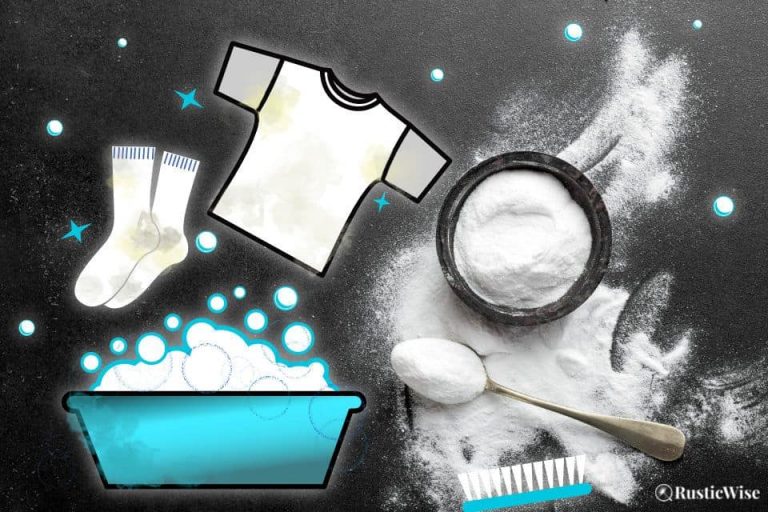Does Soap and Water Kill Salmonella? No, but Here’s What Can
Soap, whether dish soap or hand soap does many things. It removes some bacteria from hands and surfaces, cuts through grease, and lifts food particles. Its job is to clean, but it doesn’t sanitize or kill germs.
Does soap and water kill salmonella? Sadly, no, this soapy duo is not enough to remove this stubborn bacteria which can linger on surfaces for days. The USDA recommends making a liquid chlorine bleach solution of one tablespoon bleach to 1 gallon of water to kill foodborne pathogens on surfaces. Spray. Let it sit for at least 10 minutes, then wipe clean.¹
While we all want to stay safe and keep our kitchens and homes clean from harmful pathogens, it’s important to know the role soap and water plays and its limits.
I’ll also share three common household cleaning agents (other than bleach) that can kill salmonella.
What is salmonella, exactly?
Salmonella is a bacterium that can cause a type of food poisoning called salmonellosis. The term salmonella is a broad group of bacteria that includes many varieties, including S. typhi, which causes typhoid fever.²
Known as a germ with longevity and remarkable resistance, this gram-negative bacteria is anaerobic, meaning it can thrive in conditions with no oxygen.
The bacterium lives in the intestinal tracts of humans and animals, and can spread from one person or animal to another via feces.³ (Another solid reason for scrubbing your hands with soap thoroughly!)
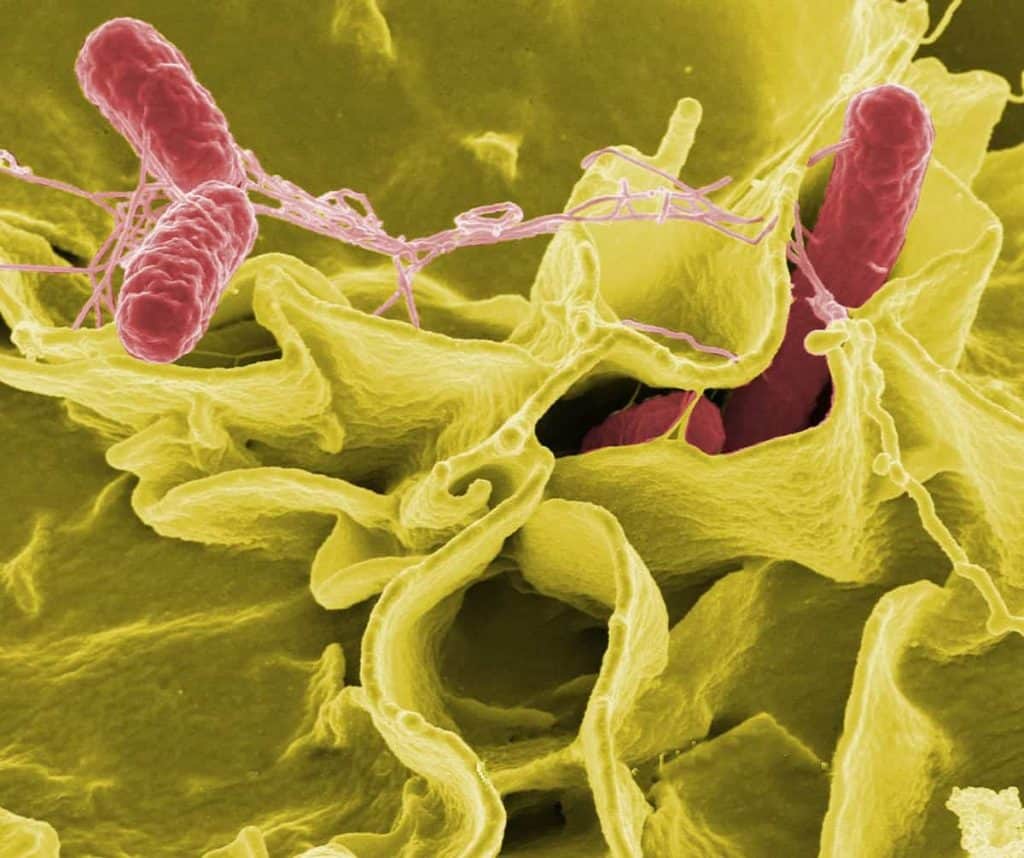
Credit: Rocky Mountain Laboratories, NIAID, NIH
Does soap and water kill salmonella?
Plain soap (whether dish soap or hand soap) and water are unfortunately not enough to kill salmonella.
Soap’s main purpose is to clean by removing dirt, grease, grime and some bacteria or viruses. It helps reduce the amount of harmful bacteria on surfaces or skin to safer levels. But soapy water does NOT kill salmonella.
What about antibacterial soap?
No, even antibacterial soap does not kill salmonella. This food-borne pathogen is still resistant to soap, antibacterial or not. While antibacterial soap is marketed as being “better” than regular suds, it’s not all it’s cracked up to be.
The U.S. Food & Drug Administration (FDA) says that regular soap and water work just fine for washing hands, no special antibacterial detergents needed. In 2016, the FDA banned triclosan and triclocarban, ingredients found in commercial antibacterial soaps; manufacturers could not prove the long-term safety of these chemicals, nor were they proven to be more effective than plain soap.⁴
How do we get sick from salmonella?
While it’s found mainly in animal products such as milk and cheese, eggs, poultry, meat, and seafood, people can also get sick from eating unwashed fruits and vegetables.
You can become infected with salmonella by eating food items that have been contaminated or improperly handled, or drinking contaminated water. Handling certain animals such as turtles, lizards, or chickens and ducks can also pose a risk.
Some symptoms of salmonellosis are fever, chills, diarrhea, abdominal cramps, vomitting, and headaches. (I’ve had salmonellosis, and trust me, it’s no fun!)
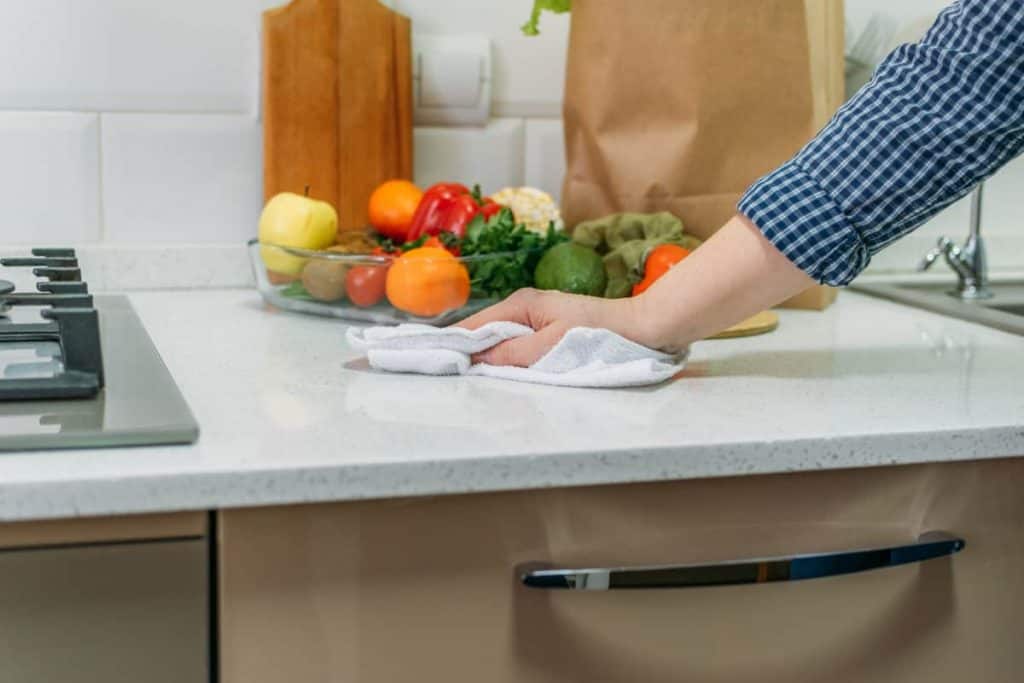
4 common household items that kill salmonella
Before you panic and go out to stock up on disinfectant wipes, you might already have the following household cleaners in your cupboard.
1. Diluted bleach solution
Bleach is one of the most common cleaners people have at home. It’s also the recommended way to effectively kill harmful bacteria, viruses, and fungi in the kitchen, according to the USDA.¹
How does bleach kill bacteria?
Bleach is a good disinfectant, and one of the most effective cleaners for killing bacteria, fungi and viruses, including influenza. The active cleaning agent in bleach is sodium hypochlorite which works by breaking down the cells of germs.
Most household liquid chlorine bleach contains between 5 to 6 percent sodium hypochlorite.
Bleach safety
Bleach is a powerful antimicrobial agent that can kill bacteria, viruses, and fungi such as mold. Widely available, and effective at killing microorganisms, it’s a popular household disinfectant.
Not surprisingly, chlorine bleach should be handled with care. Here are a few safety tips when making your own bleach solution to disinfect your kitchen and other high-use areas:
- Wear safety equipment: Protect yourself from bleach splashes by wearing rubber gloves and safety glasses. Liquid bleach is corrosive and can harm skin and eyes.
- Work in a well-ventilated area: Inhaling chlorine can irritate the respiratory system.
- Protect clothing, fabrics, and sensitive surface areas: To prevent the development of bleach stains or damaging delicate hard surfaces, cover work areas as needed.
- Don’t mix with other household cleaners: Mixing bleach with other common household cleaners can be dangerous and produce toxic fumes. NEVER mix bleach with vinegar (or other acids), or ammonia (often found in commercial cleaners such as Windex).
- Use unscented bleach: Some bottles of fragranced bleach may irritate those with sensitivities; they may also not be food-safe.
- Make a fresh batch: The chlorine in bleach becomes inactive quickly when in contact with dirt or other organic particles. It’s a good idea to mix a fresh batch of bleach solution at least once a week.⁵
How to make your own DIY bleach disinfectant
This easy recipe uses only two ingredients and is effective at killing harmful microorganisms on a wide variety of hard surfaces. The diluted nature of this solution makes it safe even on food prep surfaces such as cutting boards and utensils.
You can mix the solution and use it as a spray, or simply pour onto surfaces. Apply using a cleaning cloth or sponge.
Note: It’s vital that before you disinfect, you clean first with soapy water, then rinse with clean water. Soap will remove dirt, grime, grease, and food particles, while bleach will kill microorganisms. Just as you wouldn’t try to vacuum a messy room without first tidying up items on the floor, it’s vital to clean before sanitizing.
You’ll need:
- 1 tablespoon unscented household liquid chlorine bleach
- 1 gallon (4.5 liters) of water
- Clean spray bottle or bucket
- Combine the liquid bleach and water. Use a funnel if pouring into a spray bottle.
- Spray or apply the bleach solution to surfaces.
- Let it sit for at least 10 minutes. Some studies point to the importance of allowing a diluted bleach solution to sit for at least 10 minutes as this is the time frame necessary for the effective killing of germs.⁶ Others say that 1 minute will suffice. Use your judgement depending on the type of surface you’re cleaning.
- Wipe clean.
2. Rubbing alcohol
Yes, rubbing alcohol or isopropyl alcohol can kill salmonella if used in concentrations between 60 and 90 percent, according to the Centers for Disease Control and Prevention (CDC).⁷
Same goes for ethyl alcohol. Alcohol works by denaturing the proteins in bacterium to break them down. Alcohol is also effective at killing E. coli and Staphylococcus aureus.
3. Hydrogen peroxide
Does hydrogen peroxide kill bacteria?
Yes, an undiluted 3 percent hydrogen peroxide solution can kill salmonella, Listeria Monocytogenes, and E. Coli if left on a surface for at least 10 minutes at room temperature, 77 degrees Fahrenheit (25 degrees Celsius).⁵
To speed things up, you can heat hydrogen peroxide to 130 degrees Fahrenheit (55 degrees Celsius) and leave on for 1 minute before wiping clean. No rinsing required.
4. Vinegar
Does vinegar kill bacteria?
Yes, undiluted white distilled vinegar (5 percent acetic acid) can kill some bacteria, including salmonella, if left on a surface at room temperature for at least 10 minutes.
For more cleaning power, heat the undiluted white vinegar to 30 degrees Fahrenheit (55 degrees Celsius). Leave it on the surface for 1 minute before wiping clean. Heated vinegar will also kill Listeria Monocytogenes, and E. Coli in this manner.⁵
Cook well to avoid salmonella
Proper cooking at high heat will prevent food poisoning. Animal-based foods such as eggs, poultry, meat, and seafood should be cooked to an internal temperature of 165 degrees Fahrenheit (73.8 degrees Celsius).³
While I prefer my eggs on the runny side, apparently this is not a safe way to eat them!
How long can salmonella live on surfaces?
According to the USDA, this persistent bacteria can survive on surfaces for up to 32 hours.¹
How to sanitize dishes
Whether you or someone at home has salmonella, or you’re trying to sanitize your dishes and utensils after cooking raw chicken, here’s how to wash your dishes, utensils, and cutting boards.
You have two main options: wash your dishes by hand and let them soak in a bleach solution. Or, you can load them in the dishwasher if you have a sanitizer option.
Sanitizing dishes by hand
- Hand wash dishes using hot water and soap. Rinse clean.
- Prepare a bleach solution as outlined above (1 tablespoon liquid bleach to 1 gallon of water). I like to use a plastic basin, rather than the kitchen sink.
- Soak dishes or utensils in the bleach solution for at least 10 minutes. If washing wooden cutting boards after cutting raw meat, I like to spray rather than soak.
- Rinse clean with water.
- Let air-dry on a dish rack.
Sanitizing dishes in the dishwasher
Many dishwashers nowadays have a “sanitize” feature that is effective at killing microorganisms. The hot water sustained for a length of time helps remove any lingering bacteria and viruses on your dinnerware.
Simply load up your dirty dishes with regular dish detergent and run the sanitize cycle.
Tip: I always like to throw in my sponge, or Swedish dish cloth into the top rack of my dishwasher whenever I run a load to sanitize them.
Don’t forget the importance of washing your hands
By now we know to wash our hands and scrub vigorously with suds and warm water for at least 20 seconds. Having clean hands is one of the best ways to protect yourself by preventing harmful bacteria from entering the body. It also protects others when we practice good food safety.
Bacteria is all around us, but we don’t have to be afraid. There are many simple ways to protect ourselves and those around us.
First, we should wash our hands often. As part of good food safety, we should wash our hands every time before handling food, after handling raw meat and poultry, and after using the bathroom.
Second, we should also clean and disinfect any food contact surfaces and equipment. Using hot, soapy water followed by an effective disinfectant will help kill harmful bacteria that can make us sick.
Related questions
Does lemon juice kill bacteria?
While the citric acid in lemon juice provides some cleaning power, it’s NOT a proven way to kill germs and food-borne pathogens.
Does Castile soap work to kill microorganisms?
Castile soap, a vegetable oil based formula popular amongst the “green cleaning” crown, is sadly not effective at killing microorganisms. Just like regular suds or mild soaps, Castile is a great multipurpose cleaner, just not a great disinfectant.
👉 If you like this post, see other Timeless Cleaning Tips You Need To Know. 🌟
Would you like more timeless tips via email?
Fun tips to help you live an independent, self-sustaining lifestyle. Opt-out at any time.


References
- U.S. Department of Agriculture (USDA), https://www.usda.gov/media/blog/2019/08/27/clean-then-sanitize-one-two-punch-stop-foodborne-illness-kitchen. Accessed September 2022.
- Britannica, Salmonella, bacteria, https://www.britannica.com/science/Salmonella. Accessed September 2022.
- University of Rochester Medical Center, Salmonella Infections, https://www.urmc.rochester.edu/encyclopedia/content.aspx?contenttypeid=85&contentid=P00647. Accessed September 2022.
- U.S. Food & Drug Administration (FDA), “Antibacterial Soap? You Can Skip It, Use Plain Soap and Water,” https://www.fda.gov/consumers/consumer-updates/antibacterial-soap-you-can-skip-it-use-plain-soap-and-water. Accessed September 2022.
- Colorado State University, Cleaning & Sanitizing the Kitchen, https://extension.colostate.edu/docs/pubs/foodnut/kitchen-sanitize.pdf. Accessed September 2022.
- National Library of Medicine, Infection Prevention and Control of Epidemic- and Pandemic-Prone Acute Respiratory Infections in Health Care, https://www.ncbi.nlm.nih.gov/books/NBK214356/. Accessed September 2022.
- Centers for Disease Control and Prevention (CDC), Chemical Disinfectants, https://www.cdc.gov/infectioncontrol/guidelines/disinfection/disinfection-methods/chemical.html. Accessed September 2022.

Author: Theresa Tesolin
Theresa is co-founder of RusticWise. She helps people unleash their inner DIY spirit by encouraging them to get dirty and make or grow something from scratch.

